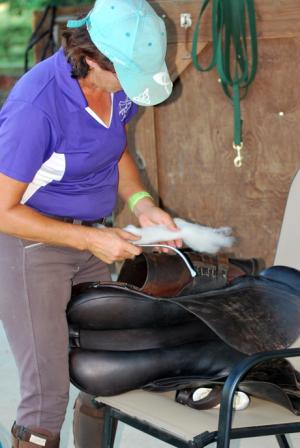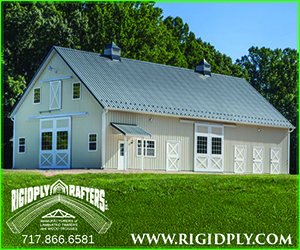By Tommy Brannon
Kate Wooten, independent English saddle fitter, paid a visit to Peggy Hart’s Misty Meadows Farm in Byhalia, Mississippi on September 18, 2015 to help riders fit their saddles to their horses. Kate travels the country from her farm in Maryville, Tennessee conducting saddle fitting clinics. She packs 72 different saddles in her vehicle so that riders can try out saddles different from their own, and so they can determine whether a different saddle may fit their horse better.
Born and raised in England, Kate does a lot of eventing, so has much experience in both dressage and the jumping disciplines. Kate takes a different approach to fitting saddles than most saddle fitters. Kate asks riders to ride their horses in the clinic and to allocate two hours of their time to do a proper, thorough saddle fitting or saddle selection.
She observes the rider actually riding the horse so that she can evaluate the saddle in motion, rather than just stationary on the horse. She commented, “If they don’t ride, what’s the point?” In addition to the saddle owner, Kate will ride at least three horses out of five so that she can feel the motion and position of the saddle. She explained why riding the horse herself is often necessary, particularly when fitting young riders to a saddle. “The 12 year old girls are often shy; they do not know how to communicate what they feel on the horse. If I ask them to choose between saddles, they may just say, ‘I like the black one.’”
One rider in for this fitting was an experienced adult fox hunter with a new horse. She wanted to make sure her saddle fit the new horse properly. Kate started with the horse on the cross ties, checking the horse’s back and conformation, and then placed the saddle on the horse. She positioned shims under the saddle and went out to the arena to see the horse and rider in action. The next step was to go back to the barn to reflock the saddle. In this case, the shims positioned the saddle forward and raised the cantle. The rider’s comment after mounting up: “I can place myself where I need to be. I hadn’t realized that it did not feel right. I didn’t even realize that I was not happy.” Kate commented that experienced riders will sometimes notice the difference right away.
Kate uses several tools specifically designed to stuff the wool flocking in the saddle. Most quality English type saddles have slots for re-stuffing. She said that she can even tell if a handmade saddle is made by a left-handed person or a right-handed person by the way it is stitched and flocked. The wool is stuffed thicker in the front or the back to change the position of the saddle. She showed the difference between a wool stuffed saddle and a foam panel saddle. The foam saddle cannot be adjusted because the foam cannot be repositioned. If you run your hand down the inside panel of a foam saddle, it will be very smooth and will not compress. The wool flocked saddle will have slight indentions on the panel. One can see the panels compressing, and the saddle does not bounce off of the horses back. “The wool will do its own job. It will go where it should go. A wool panel has about 10% compression and will pack down more in the front than in the back because the same portion of compression is over a larger area in the front,” Kate explained.
Kate finishes by giving each rider a written report about the fitting and recommends periodic refitting. This rider was very pleased with the results! Find more information about Kate at: www.englishsaddlefit.com
Kate Wooten, independent English saddle fitter, paid a visit to Peggy Hart’s Misty Meadows Farm in Byhalia, Mississippi on September 18, 2015 to help riders fit their saddles to their horses. Kate travels the country from her farm in Maryville, Tennessee conducting saddle fitting clinics. She packs 72 different saddles in her vehicle so that riders can try out saddles different from their own, and so they can determine whether a different saddle may fit their horse better.
Born and raised in England, Kate does a lot of eventing, so has much experience in both dressage and the jumping disciplines. Kate takes a different approach to fitting saddles than most saddle fitters. Kate asks riders to ride their horses in the clinic and to allocate two hours of their time to do a proper, thorough saddle fitting or saddle selection.
She observes the rider actually riding the horse so that she can evaluate the saddle in motion, rather than just stationary on the horse. She commented, “If they don’t ride, what’s the point?” In addition to the saddle owner, Kate will ride at least three horses out of five so that she can feel the motion and position of the saddle. She explained why riding the horse herself is often necessary, particularly when fitting young riders to a saddle. “The 12 year old girls are often shy; they do not know how to communicate what they feel on the horse. If I ask them to choose between saddles, they may just say, ‘I like the black one.’”
One rider in for this fitting was an experienced adult fox hunter with a new horse. She wanted to make sure her saddle fit the new horse properly. Kate started with the horse on the cross ties, checking the horse’s back and conformation, and then placed the saddle on the horse. She positioned shims under the saddle and went out to the arena to see the horse and rider in action. The next step was to go back to the barn to reflock the saddle. In this case, the shims positioned the saddle forward and raised the cantle. The rider’s comment after mounting up: “I can place myself where I need to be. I hadn’t realized that it did not feel right. I didn’t even realize that I was not happy.” Kate commented that experienced riders will sometimes notice the difference right away.
Kate uses several tools specifically designed to stuff the wool flocking in the saddle. Most quality English type saddles have slots for re-stuffing. She said that she can even tell if a handmade saddle is made by a left-handed person or a right-handed person by the way it is stitched and flocked. The wool is stuffed thicker in the front or the back to change the position of the saddle. She showed the difference between a wool stuffed saddle and a foam panel saddle. The foam saddle cannot be adjusted because the foam cannot be repositioned. If you run your hand down the inside panel of a foam saddle, it will be very smooth and will not compress. The wool flocked saddle will have slight indentions on the panel. One can see the panels compressing, and the saddle does not bounce off of the horses back. “The wool will do its own job. It will go where it should go. A wool panel has about 10% compression and will pack down more in the front than in the back because the same portion of compression is over a larger area in the front,” Kate explained.
Kate finishes by giving each rider a written report about the fitting and recommends periodic refitting. This rider was very pleased with the results! Find more information about Kate at: www.englishsaddlefit.com










